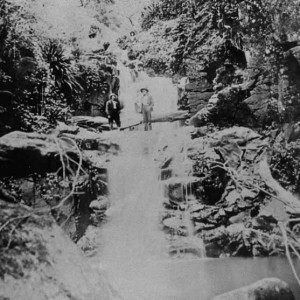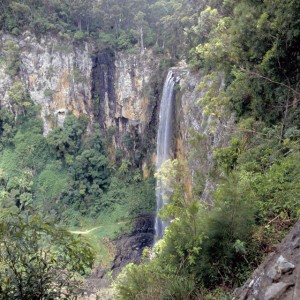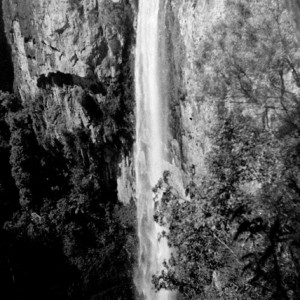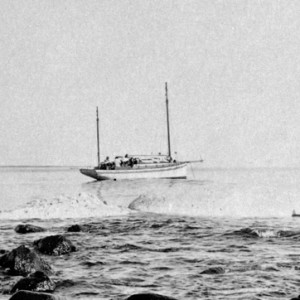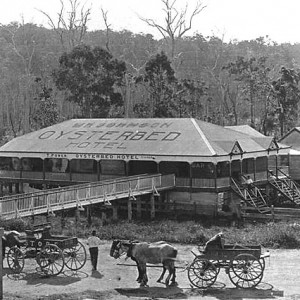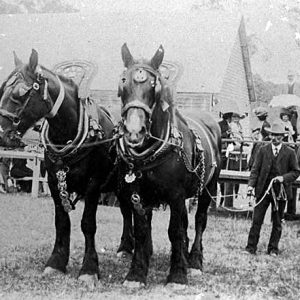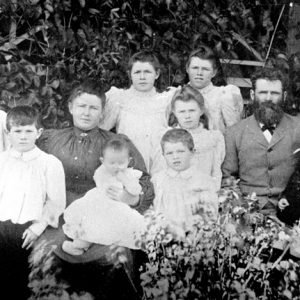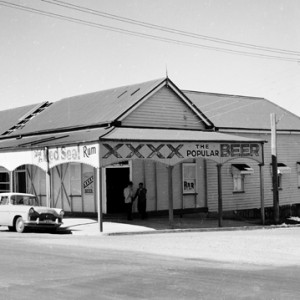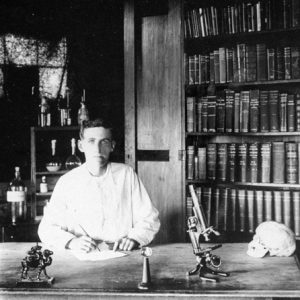
Purling Brook Falls on the Springbrook plateau travels along its stony bed before plunging over the edge of the cliff to create a 300 foot high waterfall. At the base of the cliff the water collects in a round pool before continuing its journey along the lower stream through a ravine known as the Little Nerang Gorge. Due to the different erosion rates between the top of the stream and the less resistant rock in the cliff below, the water falls like a curtain clearing the face of the cliff.
The name of the falls comes from the word ‘purl’ which is used to describe the sound made by rippling water. Surrounded on three sides by cliffs and with a long drop variously described since the early 1900s as between 230 and 540 foot high, Purling Brook Falls has long been a tourist attraction with articles telling of its beauty as one of the finest waterfalls in Australia and at least one poem appearing in newspapers.
- Purlingbrook Falls, Springbrook, 1910. Photographer unknown
- Purlingbrook Falls, Springbrook, circa 1991. Photographer Ray Sharpe
- Purlingbrook Falls, circa 1940s. Photographer Graham Hardy
With good rainfall and rich volcanic soil, the surrounding area is filled with lush vegetation including huge trees, ferns and orchids that thrive in the subtropical air. Purling Brook Falls, like other waterfalls in the vicinity, formed part of a popular walking track in the twentieth century that took in areas of natural beauty and lookouts.
The view from the falls offers an uninterrupted view to the Pacific Ocean and, even prior to modern tracks and transport options, visitors would hike to Purling Brook Falls to enjoy the spectacular view.
By the 1920s a significant section of the area had been set aside as reserve and in later years the waterfall became part of the Springbrook National Park.
In March 2015, the John Stacey Suspension Bridge across Little Nerang Creek gorge was opened as part of an upgrade of the walking track to the waterfall.
Sources of information and further reading
- Graham, Bruce. Tweed Volcanic Region: an environmental history of the Beaudesert, Gold Coast, Tweed, Brunswick and Richmond Region. [n.p.]: B. W. Graham, 2001.
- “Springbrook’s Scenic Wonderland.” (1929, December 20). The Week (Brisbane, Qld. : 1876 – 1934), p. 31. Retrieved December 7, 2015. http://nla.gov.au/nla.news-article189655751
- “The ‘green’ side of the Gold Coast.” (1982, October 27). The Australian Women’s Weekly (1933 – 1982), p. 62. Retrieved December 7, 2015. http://nla.gov.au/nla.news-article52622070
- “Springbrook.” (1930, October 11). The Telegraph (Brisbane, Qld. : 1872 – 1947), p. 16 Edition: SECOND EDITION. Retrieved December 7, 2015. http://nla.gov.au/nla.news-article184779876
- http://www.nprsr.qld.gov.au/parks/springbrook Accessed 7/12/2015.
- “Poem of the Week.” The Telegraph (Brisbane, Qld. : 1872 – 1947) 16 Jan 1943: 3 Edition: SPORTS FINAL. Web. 4 Jan 2016. http://nla.gov.au/nla.news-article186627927
- “Springbrook boasts the finest waterfall in Southern Queensland.” The Telegraph (Brisbane, Qld. : 1872 – 1947) 16 Jan 1936: 9 Edition: SECOND EDITION. Web. 4 Jan 2016. http://nla.gov.au/nla.news-article184508701
- “Springbrook’s Charms.” The Brisbane Courier (Qld. : 1864 – 1933) 18 Mar 1925: 10. Web. 4 Jan 2016. http://nla.gov.au/nla.news-article20900921
